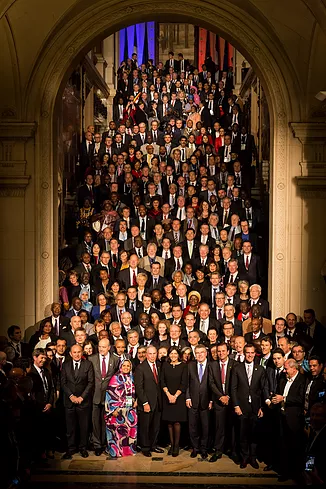In December in Paris, mayors demonstrated they are key players in the response to climate change. Habitat III can now strengthen global momentum and respond to the mayoral call to put climate-change mitigation and adaptation atop the urban agenda.

The global talks that took place in Paris in December were a great success for climate diplomacy. The long-desired universal agreement on climate change, adopted on 12 December by 195 countries, is better than could have been hoped for a year or even six months ago.
Even if the accord falls well short of what science demands, it is a major breakthrough that creates the chance to avoid the most severe impacts of climate change. Its reference to pursuing efforts to limit global average temperature increase to 1.5 degrees Celsius is the strongest acknowledgement yet of the seriousness of the problem. The agreement should be the start of a new climate economy — a critical opportunity to advance a fresh era of better, stronger, more equitable growth.
The Paris summit, known as COP 21, was also a clear success for city diplomacy. Never before had mayors showcased such engagement and leadership toward a global problem. More than 440 mayors took part in the Climate Summit for Local Leadersconvened on 4 December by Paris Mayor Anne Hidalgo and U. N. Secretary-General’s Special Envoy for Cities and Climate Change Michael R. Bloomberg. This first-of-its-kind event was the largest-ever gathering of elected local leaders on climate change.
On that historic day, local leaders collectively committed to “deliver up to 3.7 gigatons of urban greenhouse gas emissions reductions annually by 2030 — the equivalent of up to 30% of the difference between current national commitments and the 2 degree emissions reduction pathway identified by the scientific community.
”They also pledged to “support ambitious long-term climate goals such as a transition to 100% renewable energy in our communities, or a 80% greenhouse gas emissions reduction by 2050.” These pledges were offered in what’s called the Paris City Hall Declaration: A Decisive Contribution to COP 21.
City climate action was further highlighted throughout COP 21 by the Lima Paris Action Agenda, a key framework for non-state actors, including cities. Under this agenda, for instance, a “Five-year vision” to transform local and regional climate action was released. Such local-level actions are widely recognized in the COP 21 decision.
Finally, along with many other non-party stakeholders, dozens of cities expressed their commitment to implement the Paris Agreement by signing the Paris Pledge for Action. This huge mobilization definitively established cities as key players in the global solution to climate change.
Tangible action
This strong political will is now translating into tangible action. Mayors are already on course to creating sustainable, low-carbon and resilient cities.
Since 2009, C40 cities have taken 10,000 actions in sectors including adaptation, green energy, solid-waste management and energy efficiency in buildings. Over 70 percent of citywide actions are being financed by city governments themselves, according to C40 statistics released last year.
Driving this commitment and momentum is the Compact of Mayors, the world’s largest cooperative effort among city officials to reduce emissions, track that progress and prepare for climate change. This enables cities to compile emissions inventories based on a single reporting standard — the Global Protocol for Community-Scale Greenhouse Gas Emissions Inventories, or GPC.
The compact also facilitates cities to undertake climate risk assessments, set evidence-based reduction targets and develop robust climate action plans in mitigation and adaptation, achieving visibility and accountability at the global level. The results are encouraging: So far, 30 C40 cities have recorded absolute reductions in greenhouse-gas emissions.
Mayors and local leaders in power today have a huge responsibility in the next five years. Urban policy decisions made before 2020 could lock in up to a third of the remaining global “carbon budget”, according to C40 research. Investing in low-carbon, climate-resilient urban infrastructure before 2020 is thus an absolute necessity.
This urgent requirement also leads us directly to the opportunity in the current process toward Habitat III, the 20-year urbanization summit that will take place in October in Quito.
Climate as key policy driver
In a recent report, C40 explored how addressing climate change in cities produces economic, social and environmental benefits. In fact, many cities around the world are already seizing these opportunities and prioritizing climate projects based on the co-benefits they provide. Examples include Barcelona’s pedestrianization plans, Paris’s extreme-heat solution using green infrastructure, and multi-purpose spaces for flood and water management in Rotterdam.
Another great example is a project by the City of Johannesburg known as the Corridors of Freedom, which is consciously designed to achieve both climate and social-justice goals. Johannesburg’s executive mayor, Mpho Parks Tau, describes the project as “a new spatial vision to create an inclusive and economically vibrant Johannesburg”.
“This is through an integrated transit-oriented spatial development that gives Johannesburg residents access to economic opportunities and growth anchored on the principles of environmental sustainability and resilience,” Tau says.
In order to demonstrate how climate policy contributes to “make cities inclusive, safe, resilient and sustainable” — in the words of the landmark new Sustainable Development Goal 11, on cities — this year, C40 is launching a significant research programme on the co-benefits of climate action in cities.
If climate policy is a key driver of sustainable urbanization, then Habitat III should build on the momentum from COP 21 and make climate-change mitigation and adaptation overarching objectives of the New Urban Agenda, the 20-year urbanization strategy that will come out of the Quito conference. Cities can help achieve the 1.5 degree C goal through significant increases in infrastructure investment in the buildings and transport sectors.
At present, however, international funds dedicated to city action are insufficient. That is why Habitat III needs to create the conditions to unlock cities’ potential for sustainable urbanization, improving their access to finance and research, and fostering collaboration between all levels of government.
Making climate action a core component of urban policy would also contribute to achieving a better integration of the climate, development and urban agendas. In turn, this would allow many stakeholders to align their strategies and make their action in cities more efficient.
There is no single solution to climate change. While nations urgently must take action as laid out in the Paris Agreement, cities, especially megacities, are uniquely positioned to really deliver results — particularly when it comes to urban futures.
For Habitat III to be meaningful, adaptation and climate-change mitigation must be the base of the New Urban Agenda. These are key to the delivery of the resilient, low-carbon, safe, healthy, economically vibrant and inclusive cities we need.
Article originally published on Citiscope on 8 February 2016. Citiscope is a nonprofit news outlet that covers innovations in cities around the world. More at Citiscope. org.
